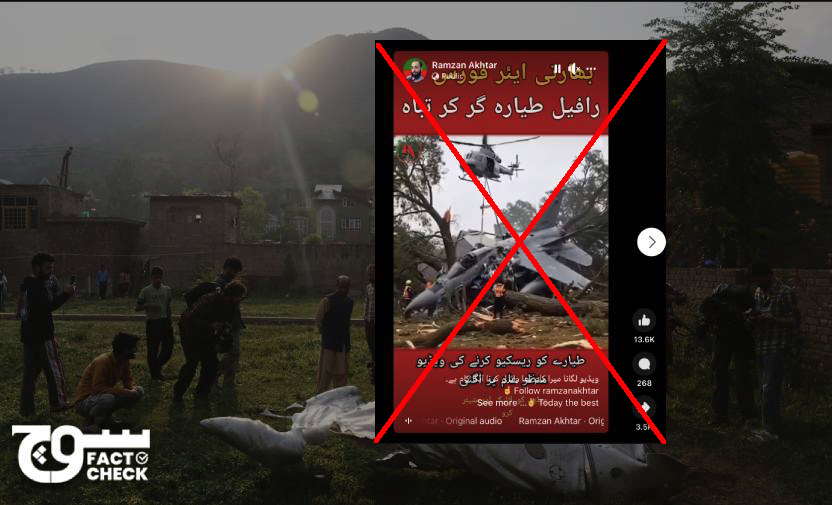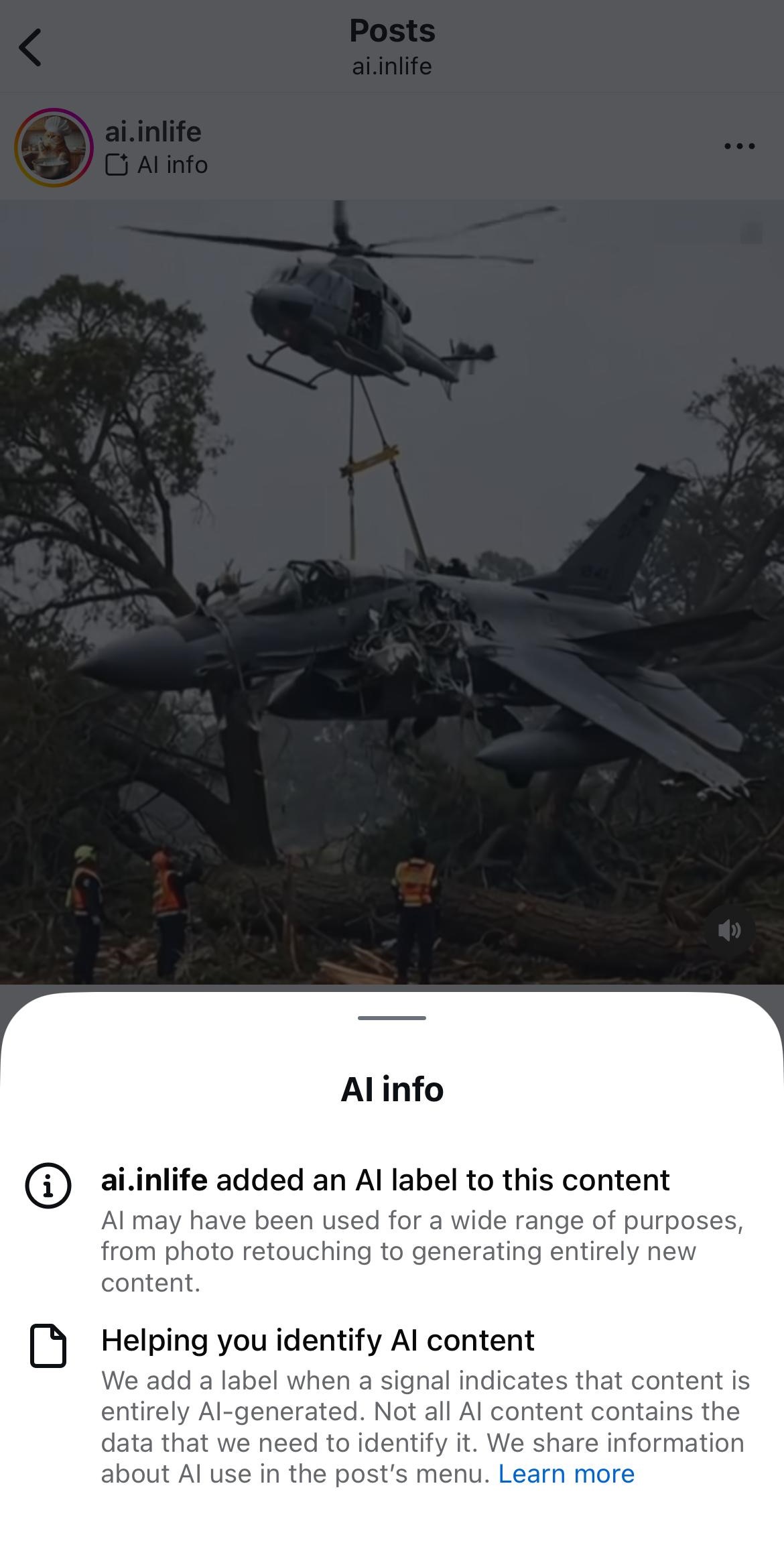
Claim: A video depicts an Indian Rafale jet after it was struck down by Pakistan.
Fact: The video is not authentic; evidence suggests it was generated using artificial intelligence (AI).
In the early hours of 7 May, India launched Operation Sindoor, striking at six locations in Pakistan and Pakistan-administered Kashmir. In response, Pakistan downed several Indian fighter jets, according to the DG ISPR. Following these developments, a video (archive) containing the following text: “بھارتی ایئر فورس کا رافیل طیارہ گر کر تباہ
طیارے کو ریسکیو کرنے کی ویڈیو ویڈیو لگانا میرا کام تھلے وائر لی کرنا آپکا کام ہے۔” was shared on Facebook.
[Translation: Indian Air Force Rafale plane crashes.
Video of plane rescue. My job is to put up a video. It’s your job to take down the wire.]
Fact or Fiction?
Soch Fact Check reverse-searched the video and found that it was shared on the Instagram account @ai.inlife on 3 May 2025. The post carried an ‘AI info’ label. We reviewed the label, which revealed that the account user had added an AI tag to the content. According to this label, AI tools could have been used on the footage for a variety of purposes, from basic retouching to the generation of entirely new content.

We reviewed the account’s bio, which indicated that the account regularly shares AI-generated content and read, “🤖 Mind-blowing AI trends ✨ Magical videos that amaze you daily,”. An examination of other videos on the account, majority of which were AI-generated further confirmed this. Examples of such videos can be viewed here, here, and here. Therefore, the video in the claim, too, is artificially generated.
Soch Fact Check also scoured credible news websites to verify whether this footage had been published in connection with the news that Pakistan had shot down Indian Rafale jets. However, we did not find any coverage of it. This further confirmed that the video is not credible and unrelated to Pakistan’s response following the air strikes by India.
Indian airstrikes in Pakistan
In the early hours of 7 May, the Indian military launched Operation Sindoor and targeted various locations inside Pakistan and Pakistan-administered Kashmir, killing at least 26 people and wounding 46 others, according to Pakistani authorities. At least three children were killed by the strikes.
The attacks marked the most expansive military action between the two nations since 1971.
Pakistan military’s media-wing Inter-Services Public Relations (ISPR) has said civilian areas in at least six locations — including Ahmedpur East, Muridke, Sialkot, Shakargarh, Kotli, and Muzaffarabad — were targeted.
India, however, alleged it targeted nine “terrorist camps”, a claim which has not yet been independently verified. Pakistan, on the other hand, has asserted that these sites are densely populated civilian areas. Emerging footage and on-ground reporting shows that civilians, including women and children, were injured in the attack, which lends credibility to Pakistan’s assertions that civilian areas were harmed, contrary to claims made by Indian officials. Soch Fact Check also independently confirmed deaths of several civilians in Bahawalpur, including two children.
Notably, military strikes in Pakistani Punjab are across a recognised international border and constitute a major escalation relative to the surgical strikes carried out along the Line of Control (LoC), the ceasefire line that divides Pakistan-administered Kashmir from Indian-administered Kashmir.
Pakistan’s Prime Minister Shehbaz Sharif condemned the airstrikes, saying his country “has every right to give a robust response to this act of war imposed by India”.
The Pahalgam Attack
India claims its strikes were a response to the terror attack in Pahalgam in Indian-administered Kashmir on 22 April, which killed 26 people, mostly tourists.
Indian officials linked the attack to Pakistan, but Islamabad has denied the claim. The Resistance Front – a group that Indian officials maintain is a proxy front for the Pakistan-based militant group Lashkar-e-Taiba (LeT) – initially claimed responsibility for that attack but later retracted its statement. Pakistan demanded a neutral investigation, asserting that India has not provided any evidence to support its allegations of Pakistan’s involvement in the attack.
The Indus Waters Treaty
Soon after the attack on tourists in Pahalgam, New Delhi announced the suspension of the Indus Waters Treaty, which has been in place since 1960 and has survived two wars between the neighbouring nuclear countries. Pakistan stated that attempts to stop or divert Pakistan’s water would be considered an “act of war and responded with full force across the complete spectrum of national power”.
On Tuesday, after a UNSC meeting to discuss the matter, Indian Prime Minister Narendra Modi said, “Now, India’s water will flow for India’s benefit, it will be conserved for India’s benefit, and it will be used for India’s progress”.
Pakistan and International response to Indian attack
Hours after Indian strikes hit multiple Pakistani locations, the Pakistani military announced that they had brought down five Indian jets. Defense Minister Khawaja Asif informed Bloomberg TV that the country shot down five Indian jets and multiple unmanned aerial vehicles, along with destroying checkposts at the Line of Control (LoC).
According to a press release issued by the Press Information Department (PID), after Pakistan’s National Security Committee (NSC) convened on the morning of 7 May, India also targeted the Neelum-Jhelum Hydropower Project. “The international media personnel had already visited these ‘imaginary terrorist camps’ on 6 May 2025 and more visits were planned for 7 May 2025,” the press release said.
After the Pahalgam incident, “Pakistan made a sincere offer for a credible, transparent and neutral investigation, which unfortunately was not accepted” by India, it added. The NSC also authorised the armed forces “to undertake corresponding actions” following the 7 May strikes by India.
The UN Secretary General António Guterres urged both India and Pakistan to exercise military restraint, adding that “the world cannot afford a military confrontation between India and Pakistan.”
The same day, Indian Prime Minister Narendra Modi chaired a high-level meeting with senior federal ministers but has so far not made any public comments since the airstrikes, according to CNN.
Following India’s attack on Pakistan, multiple countries issued statements, with Russia saying it was “deeply concerned” about the escalation, China noting that it “regrets” New Delhi’s military action and urging “restraint”, the US stating that it hoped the conflict “ends very quickly”, and the UK promising that it will “stand ready” to assist in deescalating tensions between the two countries.
A surge of unverified claims and disinformation has circulated on social media since the Pahalgam terror attack, and it has spiked sharply after India launched missile strikes into Pakistani territory early Wednesday morning.
Virality
The video was shared here (archive) on Facebook.
On YouTube, it was shared here and here.
Conclusion: The video claiming to show a destroyed Indian Rafale jet shot down by Pakistan is not authentic. Evidence suggests that it was created using artificial intelligence (AI).
–
Background image in cover photo: EPA
To appeal against our fact-check, please send an email to appeals@sochfactcheck.com
